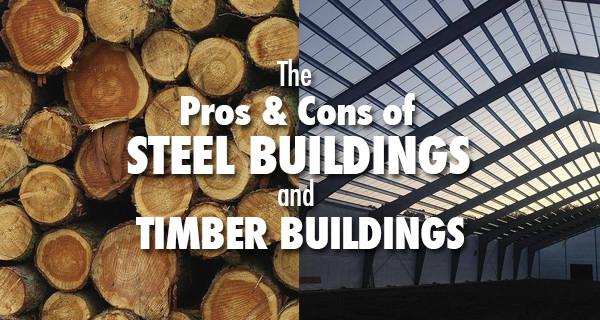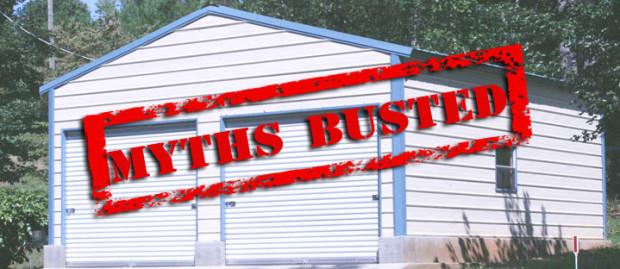Pros and Cons of Steel Buildings and Traditional Timber Buildings

As a future first time builder, you face many different obstacles in the building process. What should I build? Do I have the finances? What’s the actual maintenance of a building? Before you answer these questions, it is important to choose a building material.
The two most common building materials in use today are timber and steel. Of course, both traditional timber and steel have their advantages and disadvantages and deserve to be put to the test. It’s vital you choose the building type that’s right for your property.
Let’s start with traditional timber buildings. A traditional timber building can be sturdy and reliable. However, timber buildings aren’t the most environmentally friendly. According to the Idaho Forest Products Commission, the typical 2,400 square foot, single-family home requires about 16,000 board feet of framing lumber and over 14,000 square feet of other wood products including plywood, oriented strand board, glulam beams, wood I-joists, laminated veneer lumber, hardboard, particle board and medium-density fiberboard. When you do the math, it comes out to 60 tons of fresh trees needed to make 30,000 board feet for one average 2,400 square foot building. How many trees does it take to manufacture a steel building? Zero.
Timber buildings can provide a builder with flexible original design possibilities, but remodels could be difficult. The ability to build a grand design that includes windows and incorporates natural light is a point of contention for many people looking for residential buildings. Temperature regulation is also a positive feature of timber buildings. There usually isn’t a lot of airflow between through the walls when you build with timber, and it’s easy to regulate a wood building’s temperature. Because a steel building’s biggest foe is moisture, plan on properly insulating it to control the temperature.
Timber buildings are also susceptible to rot, mold, cracking, all types of insects and termites, and aren’t fire-resistant. Insurance companies could charge more for pole buildings or timber buildings because of their fire rating, or their overall strength and durability. Insurance is always a great measurement tool when looking to buy a building. You figure insurance agents will charge more for buildings which will need to be repaired more often, have parts replaced, or on average will see more claims. A steel building is extremely low maintenance, comes with several structural, roof and paint warranties, and won’t need replacement parts every few years.
 The biggest benefit to a steel building is the cost compared to traditional construction methods like wood framed timber buildings. I usually say steel buildings as a whole are, “half the cost and half the time to erect,” in comparison. Sure, a wood pole barn could be cheaper upfront, but that money goes out the window for every year you have to replace warped wood or rotting timber. A steel building is the ultimate long term solution to your building needs, and will cost less over the building’s lifetime, when weighed side-by-side with a pole barn or timber-framed building. In addition, land with a steel building on it tends to appreciate, while land with a wood building might stay the same, or depreciate. Steel is constantly working for you, and if you ever decide to sell your land, most likely the value has increased.
The biggest benefit to a steel building is the cost compared to traditional construction methods like wood framed timber buildings. I usually say steel buildings as a whole are, “half the cost and half the time to erect,” in comparison. Sure, a wood pole barn could be cheaper upfront, but that money goes out the window for every year you have to replace warped wood or rotting timber. A steel building is the ultimate long term solution to your building needs, and will cost less over the building’s lifetime, when weighed side-by-side with a pole barn or timber-framed building. In addition, land with a steel building on it tends to appreciate, while land with a wood building might stay the same, or depreciate. Steel is constantly working for you, and if you ever decide to sell your land, most likely the value has increased.
Steel buildings generally also have a shorter construction time. Steel buildings are delivered to a job site of your choosing ready to assemble and therefore can usually be erected in days or weeks, not months. Steel is extremely easy to clean and maintain, and if treated properly with the right coatings and paint, will typically have a longer lifespan than other materials such as traditional timber. Another major victory for steel is that it’s a ‘green product’ and completely recyclable.
When you think of a steel building, what normally comes to mind? A boxy warehouse or a boring metallic structure? Many people choose to build with wood because they simply don’t like the look of a steel building. They forsake many benefits of steel just because of the aesthetic possibilities. But what if I told you a steel building doesn’t have to look like a steel building? Steel buildings can have the outward appearance of any type of building, while retaining a steel frame.

Brick facades, vinyl sidings and even wood veneers can be added to the exterior of a steel building to give you the look you want.
You’ll always have options in any building project. It’s up to you to choose what building material works for you and your budget. If you need help deciding, or want to speak with a building consultant, give us a call or price your building online here.
Photo courtesy: David Wright
« What is ‘Oil Canning?’ How Can It Affect a Steel Building?
Don’t Just Build a Church – Build a Healthy Church! »
Popular Posts

I can tell you, almost for certain, we don’t know each other. There are hundreds of thousands of pastors and church leaders in many denominations across the country. But, even though we’re strangers, I can still guess that you didn’t get into a leadership role unless you cared about the people you intended to lead…. …

There’s a lot of information about steel buildings out there. Several misconceptions about pre-engineered steel buildings are keeping you from pulling the trigger, and sadly, they’re not true. We’re here to help you debunk four myths about steel buildings so you can get started on your next project right away. “Steel Buildings are too expensive.”… …

